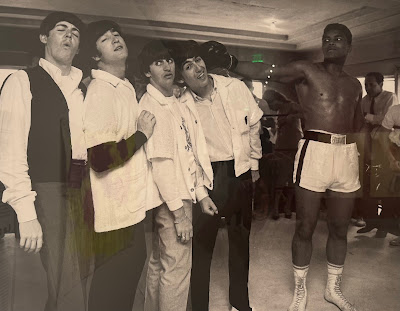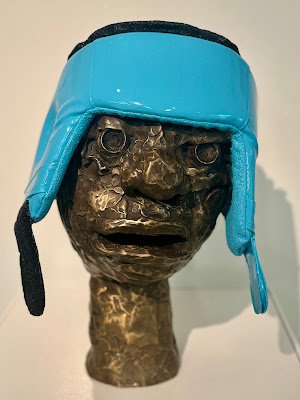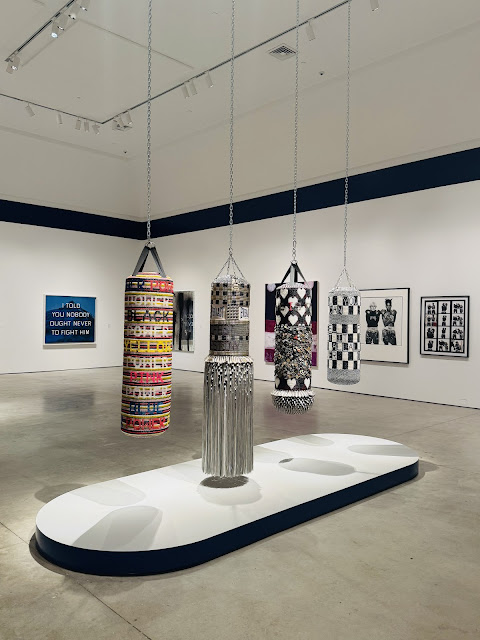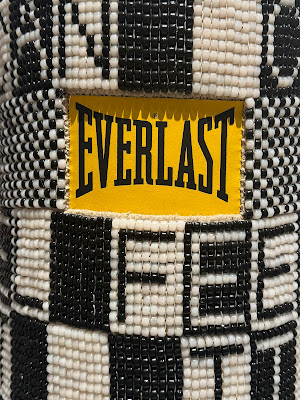 |
| Muhammad Ali by Andy Warhol (1978) |
Linn,
Paul, Sam, Chris and Christine liked it, too. Few art museums in America have as photogenic an entrance as the Norton.
Meaningful interactions with museum security guards may be rare but Mike, named for a famous boxer, chatted knowledgeably about both the sport and the art. "Some people ask if I modeled for this portrait when I tell them I've spent time in the ring," he joked.
 |
| "Seated Boxer" by Elliot Purse (2023) |
Here's his favorite work in the show. "The background is gold to help the artist convey the sense of triumph after a hard-won fight," noted Mike.
Mike had met his namesake behind-the-scenes at a Super Bowl in Miami. I had an encounter with Tyson, too, years before Mike was born when I worked at the
ASPCA. He and
Robin Givens had come to the shelter for a pet when their turbulent marriage made the tabloids on a regular basis. I tipped off the
New York Post for a photo op to publicize the adoption. It backfired when Tyson failed the screening. I can't remember why. Maybe his apartment didn't have screens on the windows or he travelled too much.
Muhammad Ali always has fascinated me. Like
Bob Dylan, he really knew how to give the media what they wanted even while manipulating them. This now iconic Sixties photo exists only because
Sonny Liston turned down a request by the Beatles,
on their first tour of America, to pose with them at the 5th Street Gym in Miami Beach. Then up and comer Cassius Clay, Ali was barely known to the rest of the world.
Who knew he could draw, too?
 |
| "Winning" (1967) |
A rare view from inside the ring is a great metaphor for fame.
 |
| "The Crowd" (1967) |
The show includes plenty of interesting artistic takes on boxing equipment such as head gear
speed bags,
and punching bags
. . . as well as gloves and other re-conceived ring attire.
Sam put up his dukes.
It's always great to see the super-realistic work of
John Ahearn & Rigoberto Torres who, for the most part, used Bronx residents as models long before people of color found greater representation in the art world.
 |
| Luis and John Kar (2003/2008) |
It's probably not a stretch to observe that boxing offers curators an opportunity to include people of color in greater numbers than would other less violent athletic pursuits. Last summer, for example,
the Flag Art Foundation, a co-sponsor of this exhibit, celebrated swimmers. Most were white. It doesn't speak well of our culture at large.
 |
"Down for the Count" (1936 - 1937)
|
More than a hundred multi media works comprise the show. This painting by
George Bellows of the
Boston Strong Boy is among the earliest. The big man holding his hat was the last heavyweight champ to fight with his bare knuckles and the first to win a million bucks in prize fight.
Both art and boxing have come a long way in the past century.
A few artists evoked the sport's violence.
 |
| "Skeleton with Boxing Gloves and Crate" by Jeanne Silverthorne (2012) |
The
New York Public Library introduced me to the work of
Alison Saar, whose
mother is also a famous artist. She certainly isn't pulling her punches in this hard-hitting work.
 |
| "Black Lightning" (2012) |
Still, you can't deny the bloodthirstiness of many spectators willing to pay top dollar to see men beat each other up.
 |
| "People's Choice" by Nari Ward (2018) |
Although the
Keith Haring sculpture wasn't in the "Gender and Sexuality" area of the exhibit, it elicited double-entendre vibes.
 |
| "Boxers" (1987-88) |
Other artists explore the homoeroticism of boxing more directly.
 |
| "Boxers Under Lights" by Katharine Bradford (2018) |
 |
"Conceptual artist #16 (Performance based; the founder and reigning champion
of a weekly pillow fight tournament)" (2023) |
One gallery features female boxers, most of whom are as tough as you might expect. Not this one.
 |
| "Gym Girl" by Amy Hill (2018) |
 |
| "Beaching The Boat (Afternoon Light)" (1903) |
 |
| "Beach of Valencia by Morning Light" (1908) |
Sorolla's portraits often have been exhibited with those of
John Singer Sargent.
 |
| "Elenita Dressed as a Menina" (1903) |
The Norton's size is conducive to quick exploration and re-acquaintance. It took me at least a minute or two to realize this guy--who looked out of of place compared to many of the Palm Beach residents who visit and support the museum--wasn't real. A cigarette would have completed the illusion.
 |
| "Moroccan Holiday: The French Collection Part II, #12 (1997) |
 |
| "Untitled (Prophet I)" (1981-82) |
Jose Luis Cuevas is known for breaking away from the Mexican muralist tradition. Too bad I was unfamiliar with this leading artist of the Generación de la Ruptura when I visited Mexico City. There's an entire museum devoted to his often ill-tempered work.
 |
| "The Journey" (1969) |
Ernest Lawson belonged to the Ashcan School. Many of the New York City-area neighborhoods he and other artists depicted are no longer impoverished. The Hudson is a lot less polluted, too.
 |
| "Hoboken Water Front" (ca 1930) |








































No comments:
Post a Comment